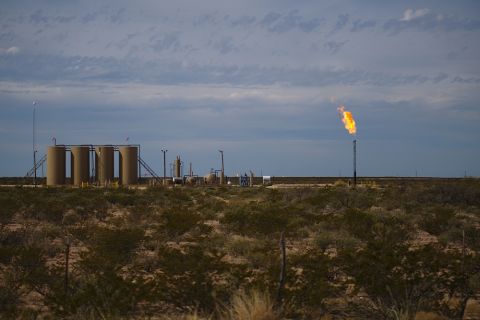This January, umbrella sales were going through the roof in rain-drenched San Francisco and Los Angeles, which got their average annual rainfall accumulations during the course of just a few weeks. But this didn't dampen the dispositions of buysiders in those markets who are exposed to energy-sector equities-not after they benefited last year from record gains in E&P and oil-service stocks. Says one portfolio manager, "Last year, we had the perfect storm." He's speaking of the confluence of tight demand/supply fundamentals, a weakening U.S. dollar, uncertainty in Middle East markets, weather disruptions in the Gulf of Mexico, and speculators and momentum players flooding the market-all of which drove crude prices to the $55 mark. Although West Coast buysiders aren't looking for the same combination of events this year, they're nonetheless forecasting sunny skies for commodity prices-$30 to $45 for oil and $5 to $6.50 for gas-along with strong market gains for E&P stocks. How strong? One San Francisco-area, hedge-fund analyst says there's enough potential in Quicksilver Resources' Barnett Shale play-not currently being paid for by the market-to double the value of that company. He eyes a similar move for Ultra Petroleum because of its accelerating production growth in Wyoming's Pinedale Anticline. Still another buysider in the same market is equally sanguine about oil-service stocks. He notes the shares of companies within that sector didn't really get off the mat until mid-2004-after independents announced their increased 2005 budgets for drilling. "So the sector is in an earlier stage of growth than E&P companies." Boiled down, the consensus on the West Coast is that the current industry cycle has long legs. The reason: fundamentals. World oil demand, now 83 million barrels per day, could hit the 100-million-barrel mark in the next 20 years. Meanwhile, on the supply side, most of the major discoveries made in recent decades are in decline-and new-field discoveries are paltry in number. So West Coast buysiders are now pouring their money into the more visible names in the industry, right? Not exactly. These market seers are looking for value and growth-and that was found most last year among the stocks of smaller-cap independents and service and supply companies. The perfect storm Aggressive in its equity exposure to energy, Beddow Capital Management Inc.-a San Francisco-based investment firm that manages some $140 million of assets-has a 20% to 25% weighting to the sector, mainly in E&P stocks. "We're a long-term, bottom-up, value investor focused on smaller-cap independents and smaller, under-appreciated names in the service sector," says William D. Tichy, portfolio manager and director of research for the firm. In 2004, that patient strategy paid off handsomely. The firm's overall energy stock-holdings rose more than 120% in value versus the prior year. This includes a 190% gain by Dawson Geophysical, a 97% jump by Denbury Resources and a 42% advance by Cimarex Energy. "Last year, we had the perfect storm," explains the former Dean Witter research analyst. World demand for oil was up 2.5 million barrels per day versus the prior year; with little excess capacity left, OPEC didn't have much wiggle room left on the supply side to bring prices down. Four hurricanes on the Gulf Coast, meanwhile, temporarily knocked out a lot of U.S. productive capacity, and hedge funds and momentum investors-many with a ready, fire, aim mentality-came flooding into the market, helping crude prices soar to the $55 mark. Yet, a rising tide can lift all boats just so far. One must look instead to the individual value-creation strategies of the firm's energy-portfolio companies to understand why their stocks so strongly outperformed relevant market indices which, year-over-year, were up a more modest 28% to 32%. In the case of Denbury, the company has a unique asset-ownership of large CO2 reserves, which it's using in the accelerated development of major tertiary oil-recovery projects in Mississippi, Tichy says. "Management doesn't need $40 or $50 oil to make terrific rates of return. It can do that at $30 oil. And in 2005, the company's production-which has a high degree of predictability-will likely be up 40% to 50% from last year." Meanwhile, Cimarex has relied mainly on growth through the drillbit. That organic growth plus a healthy balance sheet gave the company a lot of financial flexibility going into 2005. "It therefore wasn't surprising that Cimarex, which had an after-tax margin of 22% through the first nine months of 2004, was easily able to execute on its recent $2.1-billion bid for Magnum Hunter Resources," says the research director. Dawson Geophysical, which Beddow Capital bought into five years ago when the service company's market capitalization was $25 million-it's now $105 million-reflects the money manager's strategy of buying out-of-favor stocks at the bottom. During the past 18 months, Dawson has increased its seismic crews by nearly 50%, which means the company now has more crews doing more business with more sophisticated geophysical techniques. "With the current levels of horizontal drilling-and the industry's reentry into old fields like the Barnett Shale-Dawson is taking advantage of the increased need for seismic surveys," says Tichy. Although the stock was up 190% last year, he doesn't believe it's in the eighth inning of a nine-inning game. "There's some real value left." The portfolio manager is equally upbeat about the prospects for Helmerich & Payne, a company that a few years ago "went out and bought straw hats in the fall." Indeed, during 2000-03, the onshore driller spent-amid a service-sector downturn-$743 million to expand and modernize its rig fleet to more efficiently drill wells. "Today, the company has 133 rigs at work and is poised to benefit from rising dayrates-yet the stock trades at only two times price/book value versus a peer-group average multiple of 3.5 to 4," he says. "With expected revenues of $660 million for 2005-up from $595 million in 2004-this stock has a good shot at trading at three times book value." Cycle has legs During the past five years, Capital Research and Management Co., which manages The American Funds-a $600-billion-plus family of mutual funds-has been very aggressive in its equity exposure to the energy sector. Translation: an average 8% to 9% market weighting. This, however, shouldn't raise eyebrows. "In this time frame, we've had a major commodity-price upcycle-one we've awaited for 25 years. If an energy company didn't make money in this cycle, there was something dreadfully wrong with it," says Michael T. Kerr, Los Angeles-based portfolio manager for Capital Research and Management. Kerr is part of the team that manages the firm's $90-billion-plus Growth Fund of America-a growth and capital appreciation fund-and the $22-billion Fundamental Investor Fund, a classic growth and income fund. "We've been overweight energy since the late 1990s and not surprisingly, each of our equity funds has outperformed its peer Lipper index every year," he says. "In fact, without being significantly exposed to natural resources broadly and energy in particular, it's hard to see how any fund could have managed to outperform market indices." Mainstays in the firm's equity holdings on the oil-service side: Schlumberger, Halliburton and Baker Hughes. Among integrateds: Exxon Mobil, Royal Dutch and ConocoPhillips. Among E&P companies: Pogo Producing, Burlington Resources, Devon Energy, Apache and Anadarko Petroleum. In addition, the firm holds equity positions in virtually every oil-sands play in Canada, including Suncor, Shell Canada and Western Oil Sands. "The real issue going into 2005 is whether this upcycle in energy will still have legs during the next three to five years," says Kerr. "Our view is that, with so much hedge-fund speculation that drove oil prices up to $55 in late 2004, we're in an oversupply situation in world oil markets for the next six months. During this period, it's possible oil will test the $30 level." Beyond this period, however, industry fundamentals look strong enough to support $30 to $45 oil for the next three to five years-with occasional extreme price movements in a band of $25 to $55 oil, he contends. Natural gas prices, meanwhile, should remain in the $5 to $6 range. "The demand picture is very positive, whether looking at China, India or the U.S.," says Kerr. "During the next 20 years, we could see world oil consumption rise from a current level of 83 million barrels per day to 100 million barrels. On the supply side, however, most of the giant oil discoveries made 30 to 40 years ago are now in decline, and the past five years have been the worst I've seen for new-field discoveries in my 20-year career. In fact, the outlook for non-OPEC supply outside of Russia looks tepid. "So after this year, the call on OPEC oil goes up again, which is fundamentally positive for the price of the commodity." In the price environment he paints, Kerr-who makes bottom-up stock picks versus sector bets-believes oil and gas equities such as those currently being managed by Capital Research and Management will remain attractive. "Our investment thesis comes down to our view of industry management teams, which are today head and shoulders above those of 10 years ago in terms of greater financial discipline, better capital allocation, more cash returned to shareholders at the proper time, and more discipline in making acquisitions." On the natural gas side, Kerr believes E&P companies with the best prospect for growth are those that have shored up their conventional asset base with unconventional resources such as tight-sands gas and coalbed-methane plays. "These plays have lower finding and development (F&D) costs and higher returns associated with them." Noble Energy's recent acquisition of Patina Oil & Gas, he says, is a good example of such rounding out of inventory. Cost structures key An SEC-registered hedge fund with $470 million of assets under management, Palo Alto Investors in Palo Alto, California, has a 30% exposure to energy equities, mainly in the E&P and oil-service sectors. "What we look for within the micro- and small-cap end of the market is growth at a reasonable price," says David Anderson, portfolio manager and energy analyst for Palo Alto Investors who started the firm's energy practice in 2001. "True, we like to buy under-followed stocks that trade at a discount to their intrinsic value-but we're not going to invest in companies that aren't growing." A bottom-up investor, Anderson initially focused on Patina Oil & Gas, Quicksilver Resources, Ultra Petroleum and XTO Energy. The common thread among these operators is that they all have low F&D and operating costs, notes the former Chevron upstream finance and accounting expert. "Producers with good cost structures will do better if things go poorly in the commodity markets and better still when things go well. In short, they have the capacity to grow economically on a volumetric basis, regardless of where commodity prices are." He points out that when commodity prices fell in mid-2002, the cash flow of Patina actually went up. That's because the low-cost operator was able to increase volumes that offset the sting of the price drop. In addition, all these operators have long-lived reserves-another key yardstick used by Anderson. "Having long-lived reserves like Ultra-30-plus years in their case-is a huge option. If natural gas prices are headed up, I want to be the guy owning the last Mcf." This kind of investment strategy has paid off well for Palo Alto. During 2001-04, its energy portfolio-with a 60% bias to E&P stocks-achieved a 35% annual rate of return. Other upstream contributors to this performance were PetroQuest Energy, Callon Petroleum and Spinnaker Exploration. "All three have had-and are going to have-extremely good production growth in the Gulf of Mexico," he says. On the service side-a sector to which Palo Alto has a 30% equity exposure-two core holdings that have done well are Superior Energy Services and Cal Dive. "We look for service stocks that aren't just cyclical dayrate and utilization plays," says the portfolio manager. "Superior, which began as a provider of rigless plug-and-abandonment services for offshore wells, has added new services. This includes performing workovers-a business that can grow over time regardless of the cycle," he says. In the case of Cal Dive, a provider of traditional subsea construction, inspection and maintenance services, its activities have expanded to partnering in production platforms, as well as buying and producing later-stage oil and gas assets. Anderson also likes service providers with a niche focus that's growing in importance. He cites W-H Energy Services, which is involved in the burgeoning directional-drilling market. Another small-cap exposed to that market: Allis Chalmers, through its Strata Directional Drilling Services subsidiary. Back to the E&P sector, the portfolio manager near-term eyes a world of $40 oil and $6 gas with spikes on either side of those price levels. Says Anderson, "Producers like Plains Exploration that have the ability to grow their domestic production at low F&D and operating costs will continue to do well-even when prices correct." The analyst believes there's also good investment opportunity in small-cap North American operators with an international focus. He cites Torreador Resources, a Dallas-based operator focused on the Paris Basin in France and eastern Romania; Niko Resources, a Calgary-based producer with operations offshore India; and Canadian Superior, which is involved offshore Trinidad. Upstream undervalued With an 8% to 12% exposure to energy across its various equity portfolios, NWQ Investment Management Co. LLC in Los Angeles-a firm that manages some $30 billion of assets-is decidedly sanguine about the oil and gas sector. But that's not a blanket endorsement. "We're a bottom-up investor focusing on value plays within the energy arena," says Darren Peers, vice president and energy equity analyst for the firm. "And for 2005, we believe there are more pockets of undervalued companies within the E&P sector than among oil-service names that are, by and large, already fairly valued." This doesn't imply an aversion to service-sector stocks. On the contrary, NWQ did quite well in 2004 buying into Transocean, the world's largest offshore driller, at around $20 per share. Recently, the driller's shares have been trading well north of $40. That said, Peers believes there are today more investment opportunities among upstream names focused on long-lived, large resource-base plays that have visible production growth, stable cost structures and high full-cycle returns on capital employed (ROCE). "Such E&P companies, which aren't faced with turning over their drilling portfolios quickly in order to maintain production growth and hence, are less exposed to F&D-cost inflation, will be best positioned to take advantage of a rising commodity-price environment." Case in point: Denbury Resources. Focused on tertiary oil recovery in Mississippi through CO2 floods, it has a large land base, low F&D and operating costs spread across that base, and many years of drilling inventory, the analyst says. "If you believe that oil prices are headed up, as we do, then Denbury has before it great production visibility with great economics for many years-yet it's trading at only a modest premium to its peers, many of which don't have that sort of visibility." Another undervalued operator with great visibility is Range Resources, Peers contends. He notes that last year, the company expanded its natural gas position in the Appalachian Basin and became more aggressive in developing long-lived assets there-yet up until recently it hasn't been all that well understood by investors. A similarly unappreciated situation is Noble Energy. NWQ owned this stock prior to Noble's acquisition of Patina Oil & Gas because of its long-lived upstream projects in Israel, Equatorial Guinea and Ecuador. "All these projects are generating tremendous free cash flow plus the management team is a tremendous steward of capital," says Peers. "We trust it to continue to reinvest that free cash flow in projects that exceed the cost of capital." Not surprisingly, the analyst-who eyes $35 to $40 oil prices this year largely because of a weakening U.S. dollar-is also attracted to the very long-lived Canadian oil-sands play and stocks like Canadian Natural Resources, Nexen Energy and Suncor. "These companies have 50-plus years of oil-sands production before them-something not fully appreciated by the market-plus they're looking at a stable operating cost trend in that play and no exploration risk." Focus on NAV Sterling Johnston Capital Management, a San Francisco-based investment firm that manages $1.5 billion in assets, has an overweight 10% exposure to energy equities that was split evenly in 2004 between small-cap E&P and service stocks. Both sectors performed well for the firm, up 30% and 20% for the year, respectively. But there were some notable outperformers. "The best-performing E&P stock in 2004 within our small-cap universe-companies that are under $1.5 billion in market cap-was TransGlobe Energy, up 100% in value," says Tim Chatard, portfolio manager, energy analyst and partner at Sterling Johnston. An unusual investment for the fund, this Calgary-based, Yemen-focused producer's market cap was below $100 million when the fund invested in it and is now $319 million. "But it's an excellent example of the kind of E&P company we look for: a drillbit-focused operator with the ability to grow net asset value (NAV) by multiples over a three- to five-year time frame," Chatard says. "I'm not looking for an E&P company that's trading at 4.5 times cash flow versus a peer-group average multiple of 4.8, with the hopes that I can capture the disparity in valuation. I'm more concerned with an operator's ability to grow its NAV from $5 to $20 per share during the next five years." Another upstream stock that outperformed for the buysider last year was Southwestern Energy, up more than 30%. This company was already perceived by investors as a good organic-growth play, given its success in the Overton Field and the Ranger Anticline conventional gas plays in Texas and Arkansas. But its stock took off in 2004 in part because of its entrance into the Fayetteville shale play in Arkansas, says Chatard, who is a former Morgan Stanley M&A analyst. "It's within such unconventional plays that we've uncovered considerable organic-growth opportunities during the past five years." This includes investments in tight-sands gas and coalbed-methane operators, such as Ultra Petroleum, Double Eagle Petroleum, Quicksilver Resources and Range Resources. But the analyst points out there are other producers, such as Edge Petroleum and Energy Partners Ltd., that are exposed to conventional plays, but still have the ability to grow organically and increase NAV. On the service side, the firm also did well last year with Willbros Group, a pipeline construction company whose stock was up nearly 50%, as well as Superior Energy Services, an offshore-services provider whose stock was up more than 30% in value. This year, Sterling Johnston has increased its bias to oil-service companies within the energy part of its equity portfolios to 60%-up from 50% in 2004-and with good reason. "Although 2004 was a great year for energy stocks-those of E&P operators in particular-the shares of service-sector companies really didn't get off the mat until midyear when E&P companies announced their increased 2005 budgets for drilling," explains Chatard. "Now, with good drilling activity and hence, revenue and earnings growth ahead of the sector in 2005 and probably 2006, we feel comfortable owning more of the shares of smaller-cap names within the group. Very simply, the service sector is in an earlier stage of growth today than E&P companies." Current Sterling Johnston service-sector holdings include Willbros Group, which Chatard feels should continue to be a good performer given its 2005-2007 inventory of pipeline projects; Core Labs, which is involved in reservoir analysis; and Input/Output, which is focused on seismic data acquisition, processing and interpretation. "Another focused, smaller-cap service stock-one we don't own-is Carbo Ceramics, a seller of proppants used in the downhole fracing of wells," says Chatard. "In each case, these service companies have a niche that should enable them to maintain pricing and profitability, even against their bigger competitors in the sector."
Recommended Reading
Waha NatGas Prices Go Negative
2024-03-14 - An Enterprise Partners executive said conditions make for a strong LNG export market at an industry lunch on March 14.
Enbridge Announces $500MM Investment in Gulf Coast Facilities
2024-03-06 - Enbridge’s 2024 budget will go primarily towards crude export and storage, advancing plans that see continued growth in power generated by natural gas.
Summit Midstream Launches Double E Pipeline Open Season
2024-04-02 - The Double E pipeline is set to deliver gas to the Waha Hub before the Matterhorn Express pipeline provides sorely needed takeaway capacity, an analyst said.
Williams Beats 2023 Expectations, Touts Natgas Infrastructure Additions
2024-02-14 - Williams to continue developing natural gas infrastructure in 2024 with growth capex expected to top $1.45 billion.
Kinder Morgan Sees Need for Another Permian NatGas Pipeline
2024-04-18 - Negative prices, tight capacity and upcoming demand are driving natural gas leaders at Kinder Morgan to think about more takeaway capacity.





